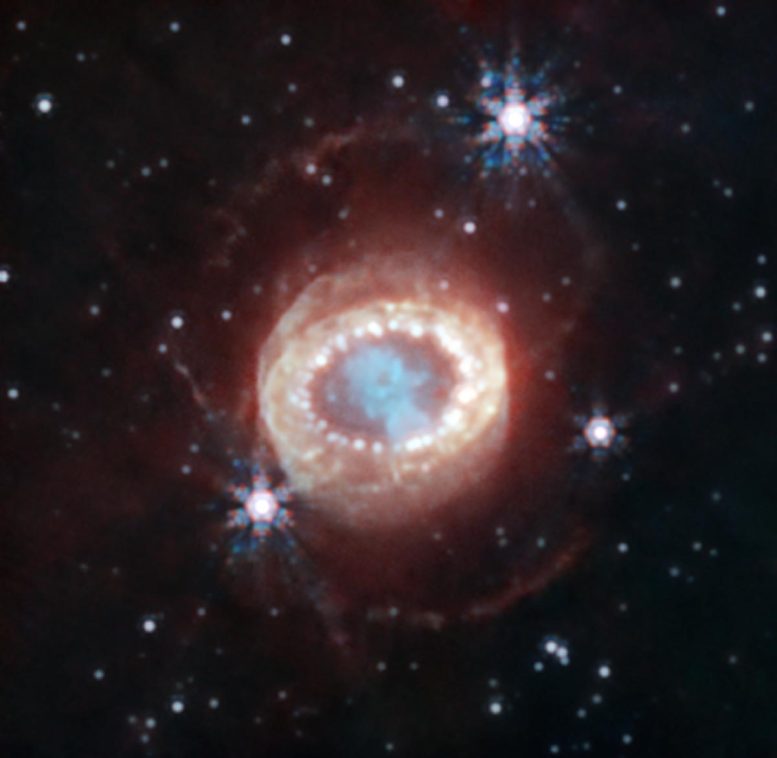
Webb’s NIRCam (Near-Infrared Camera) captured this detailed image of SN 1987A (Supernova 1987A) with unprecedented clarity, revealing new structures and deepening our understanding of this celestial event. Credit: NASA, ESA, CSA, Mikako Matsuura (Cardiff University), Richard Arendt (NASA-GSFC, UMBC), Claes Fransson (Stockholm University), Josefin Larsson (KTH), Alyssa Pagan (STScI)
Small crescent-like structures come into clear view.
NASA’s James Webb Space Telescope has uncovered new details in Supernova 1987A with its NIRCam (Near-Infrared Camera) instrument. Structures, some only visible in infrared wavelengths, provide clues into the development of supernovas over time.
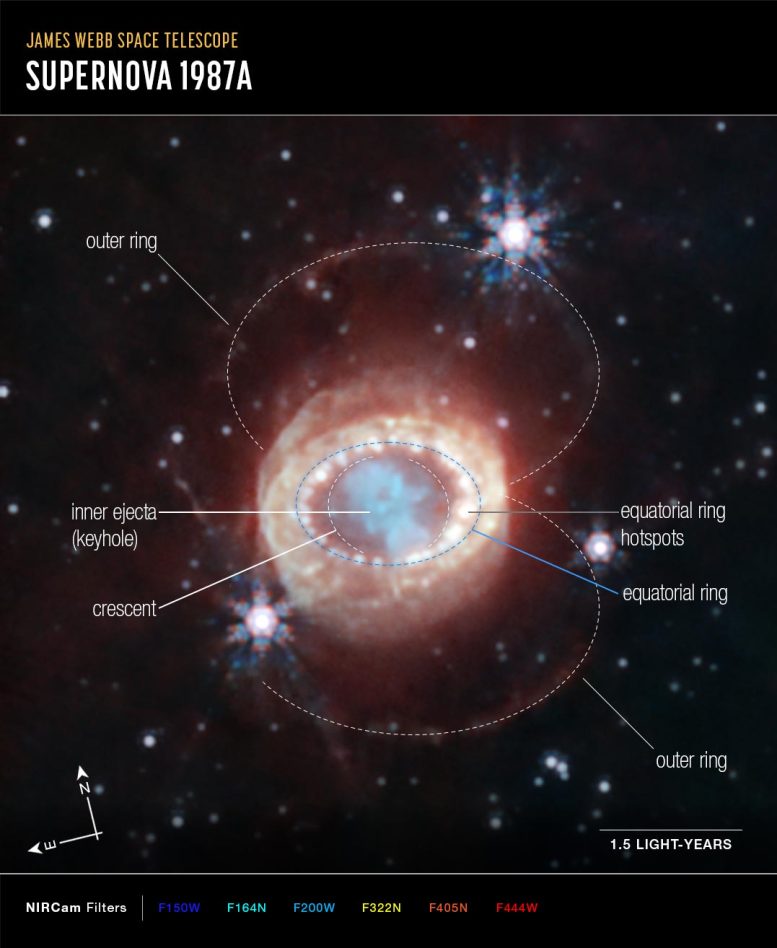
Webb’s NIRCam (Near-Infrared Camera) captured this detailed image of SN 1987A (Supernova 1987A), which has been annotated to highlight key structures. At the center, material ejected from the supernova forms a keyhole shape. Just to its left and right are faint crescents newly discovered by Webb. Beyond them an equatorial ring, formed from material ejected tens of thousands of years before the supernova explosion, contains bright hot spots. Exterior to that is diffuse emission and two faint outer rings. In this image blue represents light at 1.5 microns (F150W), cyan 1.64 and 2.0 microns (F164N, F200W), yellow 3.23 microns (F323N), orange 4.05 microns (F405N), and red 4.44 microns (F444W).
Credit: NASA, ESA, CSA, Mikako Matsuura (Cardiff University), Richard Arendt (NASA-GSFC, UMBC), Claes Fransson (Stockholm University), Josefin Larsson (KTH), Alyssa Pagan (STScI)
Webb Space Telescope Reveals New Structures Within Iconic Supernova
NASA’s James Webb Space Telescope has begun the study of one of the most renowned supernovae, SN 1987A (Supernova 1987A). Located 168,000 light-years away in the Large Magellanic Cloud, SN 1987A has been a target of intense observations at wavelengths ranging from gamma rays to radio for nearly 40 years, since its discovery in February of 1987. New observations by Webb’s NIRCam (Near-Infrared Camera) provide a crucial clue to our understanding of how a supernova develops over time to shape its remnant.
Key Observational Features
This image reveals a central structure like a keyhole. This center is packed with clumpy gas and dust ejected by the supernova explosion. The dust is so dense that even near-infrared light that Webb detects can’t penetrate it, shaping the dark “hole” in the keyhole.
This time-lapse sequence of images taken by the Hubble Space Telescope’s Wide Field Planetary Camera 2 and Advanced Camera for Surveys show changes in the ring of matter surrounding a stellar explosion, called Supernova 1987A. This spectacular light show is the collision of the debris with the gas ring that circles the site of the explosion as seen from September 24, 1994, to November 28, 2003. Credit: NASA and L. Barranger (STScI); Images: NASA, P. Challis, R. Kirshner (Harvard-Smithsonian CfA), B. Sugerman (STScI)
A bright, equatorial ring surrounds the inner keyhole, forming a band around the waist that connects two faint arms of hourglass-shaped outer rings. The equatorial ring, formed from material ejected tens of thousands of years before the supernova explosion, contains bright hot spots, which appeared as the supernova’s shock wave hit the ring (see video above). Now spots are found even exterior to the ring, with diffuse emission surrounding it. These are the locations of supernova shocks hitting more exterior material.
Comparative Insights and New Discoveries
While these structures have been observed to varying degrees by NASA’s Hubble and Spitzer Space Telescopes and Chandra X-ray Observatory, the unparalleled sensitivity and spatial resolution of Webb revealed a new feature in this supernova remnant – small crescent-like structures. These crescents are thought to be a part of the outer layers of gas shot out from the supernova explosion. Their brightness may be an indication of limb brightening, an optical phenomenon that results from viewing the expanding material in three dimensions. In other words, our viewing angle makes it appear that there is more material in these two crescents than there actually may be.
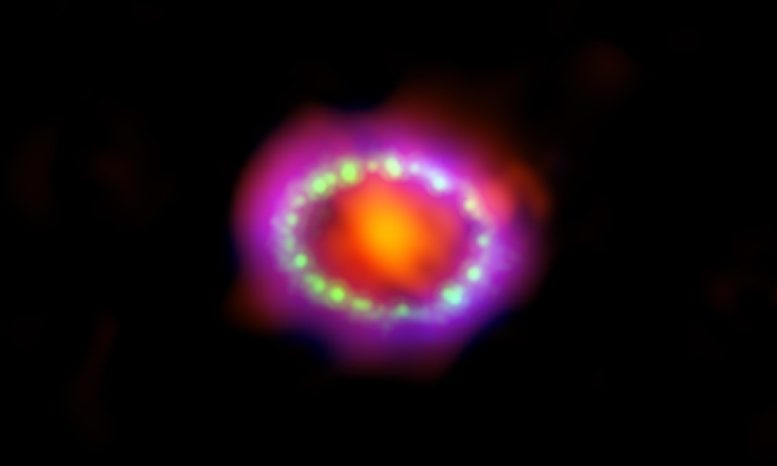
Astronomers combined observations from three different observatories (Atacama Large Millimeter/submillimeter Array, red; Hubble, green; Chandra X-ray Observatory, blue) to produce this colorful, multiwavelength image of the intricate remains of Supernova 1987A.
Credit: NASA, ESA, A. Angelich (NRAO, AUI, NSF)
Hubble image: NASA, ESA, and R. Kirshner (Harvard-Smithsonian Center for Astrophysics and Gordon and Betty Moore Foundation)
Chandra image: NASA/CXC/Penn State/K. Frank et al.
ALMA image: ALMA (ESO/NAOJ/NRAO) and R. Indebetouw (NRAO/AUI/NSF)
The high resolution of these images is also noteworthy. Before Webb, the now-retired Spitzer telescope observed this supernova in infrared throughout its entire lifespan, yielding key data about how its emissions evolved over time. However, it was never able to observe the supernova with such clarity and detail.
Unraveling Mysteries and Future Studies
Despite the decades of study since the supernova’s initial discovery, there are several mysteries that remain, particularly surrounding the neutron star that should have been formed in the aftermath of the supernova explosion.
Like Spitzer, Webb will continue to observe the supernova over time. Its NIRSpec (Near-Infrared Spectrograph) and MIRI (Mid-Infrared Instrument) instruments will offer astronomers the ability to capture new, high-fidelity infrared data over time and gain new insights into the newly identified crescent structures. Further, Webb will continue to collaborate with Hubble, Chandra, and other observatories to provide new insights into the past and future of this legendary supernova.
The James Webb Space Telescope is the world’s premier space science observatory. Webb is solving mysteries in our solar system, looking beyond to distant worlds around other stars, and probing the mysterious structures and origins of our universe and our place in it. Webb is an international program led by NASA with its partners, ESA (European Space Agency) and the Canadian Space Agency.


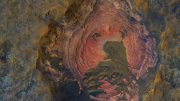
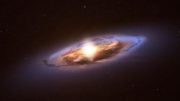





Be the first to comment on "Cosmic Keyhole: Webb Reveals Breathtaking New Structures Within Iconic Supernova"